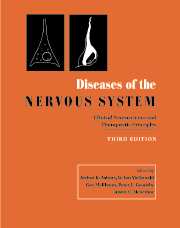Book contents
- Frontmatter
- Dedication
- Contents
- List of contributors
- Editor's preface
- PART I INTRODUCTION AND GENERAL PRINCIPLES
- PART II DISORDERS OF HIGHER FUNCTION
- PART III DISORDERS OF MOTOR CONTROL
- 31 Mechanisms of motor control
- 32 The apraxias
- 33 Parkinson's disease
- 34 Other extrapyramidal syndromes: parkinsonism-plus and other forms of secondary parkinsonism
- 35 Tremors
- 36 Myoclonus
- 37 Dystonia
- 38 Tourette syndrome
- 39 Cerebral palsy
- 40 Gait and balance disorders
- PART IV DISORDERS OF THE SPECIAL SENSES
- PART V DISORDERS OF SPINE AND SPINAL CORD
- PART VI DISORDERS OF BODY FUNCTION
- PART VII HEADACHE AND PAIN
- PART VIII NEUROMUSCULAR DISORDERS
- PART IX EPILEPSY
- PART X CEREBROVASCULAR DISORDERS
- PART XI NEOPLASTIC DISORDERS
- PART XII AUTOIMMUNE DISORDERS
- PART XIII DISORDERS OF MYELIN
- PART XIV INFECTIONS
- PART XV TRAUMA AND TOXIC DISORDERS
- PART XVI DEGENERATIVE DISORDERS
- PART XVII NEUROLOGICAL MANIFESTATIONS OF SYSTEMIC CONDITIONS
- Complete two-volume index
- Plate Section
37 - Dystonia
from PART III - DISORDERS OF MOTOR CONTROL
Published online by Cambridge University Press: 05 August 2016
- Frontmatter
- Dedication
- Contents
- List of contributors
- Editor's preface
- PART I INTRODUCTION AND GENERAL PRINCIPLES
- PART II DISORDERS OF HIGHER FUNCTION
- PART III DISORDERS OF MOTOR CONTROL
- 31 Mechanisms of motor control
- 32 The apraxias
- 33 Parkinson's disease
- 34 Other extrapyramidal syndromes: parkinsonism-plus and other forms of secondary parkinsonism
- 35 Tremors
- 36 Myoclonus
- 37 Dystonia
- 38 Tourette syndrome
- 39 Cerebral palsy
- 40 Gait and balance disorders
- PART IV DISORDERS OF THE SPECIAL SENSES
- PART V DISORDERS OF SPINE AND SPINAL CORD
- PART VI DISORDERS OF BODY FUNCTION
- PART VII HEADACHE AND PAIN
- PART VIII NEUROMUSCULAR DISORDERS
- PART IX EPILEPSY
- PART X CEREBROVASCULAR DISORDERS
- PART XI NEOPLASTIC DISORDERS
- PART XII AUTOIMMUNE DISORDERS
- PART XIII DISORDERS OF MYELIN
- PART XIV INFECTIONS
- PART XV TRAUMA AND TOXIC DISORDERS
- PART XVI DEGENERATIVE DISORDERS
- PART XVII NEUROLOGICAL MANIFESTATIONS OF SYSTEMIC CONDITIONS
- Complete two-volume index
- Plate Section
Summary
Dystonia is a movement disorder characterized by sustained involuntary muscle contraction causing abnormal twisting, repetitive movements or posturing that tend to have a directional predominance.Descriptions of dystonic patients, who were often believed to be hysterical, first appeared at the beginning of the twentieth century (Zeman & Dyken, 1968). In 1908, Schwalbe ascertained the hereditary nature of the illness and its variable expression (Schwalbe, 1908). The term‘dystonia musculorum deformans’ was first used by Oppenheim (1911), while Mendel and Flateau, emphasizing the twisted posture, called the disease ‘torsion dystonia’ or ‘torsion spasm’ (Flateau & Sterling, 1911; Zeman & Dyken, 1968).
After a period of relative inattention, interest in dystonia revived in the 1970s with a fuller delineation of the symptomatology allowing the recognition of focal forms. More recent technological developments have culminated in the identification of genetic mutations underlying generalized torsion dystonia, dopa-responsive dystonia, and some focal dystonias. New therapies have been developed including botulinum toxin injections, stereotactic surgery, and deep brain stimulation.
Classification
Dystonia can be classified by etiology, by the body area involved, and by the age of onset. The division by etiology into primary (idiopathic) and secondary (symptomatic) dystonia provides a schema for evaluating the patient. The classification by affected region is especially useful for the primary dystonias, where the epidemiology, prognosis, treatment and genetics differ by dystonia type. Classifying dystonia by age of onset is also most applicable to primary dystonia, where it serves to separate idiopathic generalized torsion dystonia of childhood onset from the focal dystonias which typically present in adulthood.
A classification suggested by Fahn et al., divides dystonias into primary dystonia, ‘dystonia-plus’ syndromes in which dystonia combines with other neurological symptomatology, secondary dystonia where an underlying pathological process causing dystonia can be identified, and heredofamilial dystonia in which there is an underlying neurodegenerative disorder (Fahn et al., 1998).
Signs and symptoms
Idiopathic dystonia often first manifests as a feeling of discomfort or stiffness in the affected body part. Abnormal movement ensues and initially may only be apparent when performing specific acts, interfering with smooth and accurate performance. As it progresses, dystonia occurs with other voluntary movements and may eventually be present even at rest. Dystonic muscles may hypertrophy; fixed contractures and deformity occur in severe cases. Dystonia disappears during sleep.
- Type
- Chapter
- Information
- Diseases of the Nervous SystemClinical Neuroscience and Therapeutic Principles, pp. 532 - 550Publisher: Cambridge University PressPrint publication year: 2002

